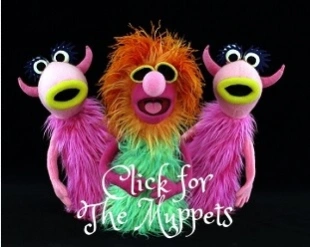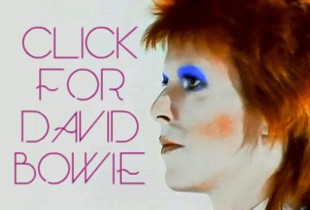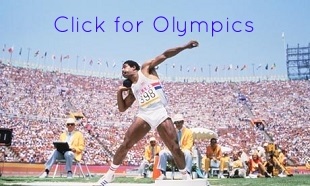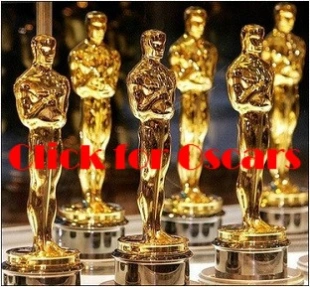Sounds familiar: the ten greatest ever cover versions
“Denied!”: Sorry, Wayne (and Rolf) – only the best covers have made it on to this list
Let’s be honest, most of them have been pap – for every easy listening-tastic Sinatra recording of Something there’s an oh-god-why Samantha Fox doing Satisfaction – but one or two have been decent, or even more than decent. Well, one or two. Yes, we’re talking cover versions here.
And the other day I set myself the task to note down the ten best cover versions ever to be committed to tape in a recording studio and listened to by yours truly – no, there’s been no straw poll conducted here, this is merely and entirely a subjective run-down from tenth-best to the very best.
So, make sure you’re sitting comfortably, peeps – and, remember, there’s no greater flattery than the art of imitation – and this lot really have made it an art…
Click on the song titles to hear examples
~~~
10 It Must Be Love ~ Madness, 1981
(Original version: Labi Siffre, 1971)
So, to kick off the countdown is a proper prince among pop covers from the ’80s’ biggest selling band in the UK. In spite of its use in a TV commercial last year, the original still remains little known, but it’s a charming jem – an upbeat, sunny early ’70s ditty that deserves many a listen. The cover, though, is unforgettable, of course. Suggs and friends took singer-songwriter Labi Siffre’s tune and, turning their back on ska and going for more pure pop sensibilities, used saxophones, strings and studio polish to produce a hit-and-a-half that marched up to Number 4 in the UK charts. But what of the likeable Labi Siffre? Well, 16 years after recording the first It Must Be Love, he hit the big-time again in 1987 with anti-apartheid anthem Something Inside So Strong. See, it really must’ve been love – it turned out nice for everyone in the end.
~~~
9 You’ve Got The Love ~ Florence + The Machine, 2009
(Original version: The Source, Featuring Candi Staton, 1991)
The original was a standard of late-’80s/ early-’90s pop soul, smattered with an acid house-style backing beat, but Florence + The Machine’s very recent cover (easily the youngest on this list) is a quality effort in my book – true quality. Florence (real surname Welch) and her ‘Machine’ (her backing group) not only have taken the song and given it a whole lease of new life, as all successful covers do, but reimagined it for a new generation of British pop followers. Theirs is a version that’s arguably even more urgent than the original, with its indie guitar-driven feel and heavy drums, yet it also has a sort of a transcendental effect with the touches of harp and overdubbing of Florence’s soaring and pulsating vocals. Few modern covers are worth the listen; this one’s worth several, one after another.
~~~
8 I Fought The Law ~ The Clash, 1979
(Original version: Sonny Curtis And The Crickets, 1959)
Bet you didn’t know this one was a cover, did you? If not, feel very smug with yourself – you get 1,000 brownie points. Yes, one of the all time Clash classics was, in a former life, a rather hickey yet fun rock ‘n’ roll ditty recorded by The Crickets with a new front man after they split with the unforgettable Buddy Holly. Indeed, do give the original a listen – it’s quite the curate’s egg. As for Joe & Co’s version, well, it’s an absolute psuedo-punk classic of course, its lyrics and simple-sounding structure fitting perfectly with the band’s radical, visceral, leftist image to a tee. Since The Clash, it’s been covered a host of times by everyone from Chumbawumba to Status Quo; before them it was covered – perhaps most famously in the States – by the Bobby Fuller Four in 1965. The Clash’s version was added to the US edition of their The Cost Of Living album, and the single itself criminally only reached Number 27 in the UK charts.
~~~
7 Everybody’s Talkin’ ~ Harry Nilsson, 1968
(Original version: Fred Neil, 1966)
And here’s another cast-iron classic that, again, probably few know was in fact a cover. Yes, playing optimistically as it did in Midnight Cowboy (in wonderful counterpoint to what was going on on-screen), it probably isn’t a stretch to say that Nilsson’s smooth, easy and oh-so agreeable version of Everybody’s Talkin’ helped define the close of the ’60s in America – all that hope, belief and goodwill of a few years earlier going up in smoke with Martin Luther King’s assassination, Nixon and the deepening hell that was Vietnam. It’s like an ironic cheer for the urban mess of 1969 New York and a satirical greeting for the hard realities the ’70s would bring. However, country singer Fred Neil’s original effort from a few years earlier had no such arty faux connotation to it, being a genuinely jaunty, upbeat song that seems to have been lost in the annals of music history thanks to the monster hit it bequeathed just three years later. I’m sure he never expected that – just as the world didn’t expect Midnight Cowboy, a film with an X-rating, to waltz off with the Best Picture Oscar that year. The times they had ‘a-changed, indeed.
~~~
6 Alfie ~ Cilla Black, 1966
(Original version: Cher, 1966)
Watch the end of Alfie again and you may be surprised – if you come from the UK, that is. For the titular Bacharach/ David-penned theme that closes said film is neither the version we all know so well, nor is it sung by the national institution that is Cilla Black. Nope, you’ll discover that what plays over the flick’s fantastically trendy end credits is actually a clunky yet cool rendition delivered by none other than Yank diva Cher. How so, you may wonder? Well, Cher’s ’60s beau Sonny Bono was, perhaps a little randomly, the composer of this Brit flick that almost single-handedly sums up the Swinging Sixties – and, rightly or wrongly, he presumably had the muscle with the producers to ensure his girlfriend got the gig for the movie.
But Cher’s, of course, wasn’t the big chart hit – that honour (over here, at least) went to arr Cilla. In fact, this version, with its epic, three-course-dinner-like orchestral sound, was recorded entirely live at Abbey Road Studios – with Cilla singing along with the full orchestra for each take. And there were a hell of a lot of takes too – so many that George Martin, who produced all of Cilla’s recordings at this time, had to step in and ask Bacharach (conducting the orchestra himself) just how many takes he was going to make the young rising star sing. The great one’s reply was that he was waiting for that one, single take that was ‘perfect’. Judge for yourself whether they found it.
~~~
5 Twist And Shout ~ The Beatles, 1963
(Original version: The Top Notes, 1961)
Such a fans’ favourite was The Fabs’ version of this r ‘n’ b classic that they always used to close their early sets with a raucous rendition of it. In fact, its raucous nature was the very reason why it was the set-closer, as its performance took too much of a toll on John’s vocal chords to appear elsewhere on the bill. Fondly recalled by all and sundry for John and George’s mop-topped head-shaking during their ‘oooh’ answers to John’s delivery of the title line, it’s also remembered by ’80s teen flick enthusiasts as the tune Ferris Bueller mimes and dances to (along with an entire parade through the streets of Chicago) while on his eponymous day off – which, in fact, gave it a whole new lease of life in the States and sent it back to the top of the charts in the summer of 1986.
But it shouldn’t be ignored that before The Beatles made it theirs, Twist And Shout was made hugely popular by The Isley Brothers a year before; indeed, if it weren’t for this original cover there’d have been no Fabs effort. Word to the wise: listen out for Lennon’s classic wisecrack intro to the 1964 Royal Variety Performance recording in the above link – it’s a humdinger, all right.
~~~
4 The Star-Spangled Banner ~ Jimi Hendrix, 1968
(Original version: Francis Scott Key/ John Stafford Smith)
Of course, there’s never really been a definitive – or indeed – original version of the US national anthem, or to give it its proper name The Star Spangled Banner (the lyrics of which came from the poem The Defence Of Fort McHenry by Francis Scott Lee and the tune from a British drinking song by John Stafford Smith). But if anything’s for sure then it must be that, when fully realised and having firmly found its vocation, this proud paean to all that is patriotically good about America was never intended to be covered in the way guitar god Jimi Hendrix did in the late-’60s. Instead of highlighting the distopyan view of the US many of its young people held at that time in the almost satiric manner the Everybody’s Talkin’/ Midnight Cowboy combo did, Hendrix went right for the jugular with his performances of his country’s national anthem – often closing his sets with it, in fact.
Drawing out the infamous notes of the melody in a manner that’s not a million miles away from one scratching their fingernails down a blackboard, he managed to make the notes themselves seem to screech, whimper and howl, as if in pity and pain. The effect was also aided by feedback and simulated sounds of gunfire and explosions (the sounds of war,if you will). Right or wrong, there’s no doubt what he was trying to say – the country is f***** and so are we. Best remembered, as it always will be, as the closer to his set at August 1969’s Woodstock Festival, this iconic – and so very different – version of an instantly recognisable piece of music simply has be one of the all-time great covers.
~~~
3 Mr Tambourine Man ~ The Byrds, 1965
(Original version: Bob Dylan, 1965)
There’s a simple, pure, oh-so folky joy to Dylan’s original version of this all-time standard of pop/ rock songwriting; it’s sweet and touching in many ways – his vocal delivery emphasises the whole point of the lyrics. But is the cover better than the original? Well, I’m very, very loathe to besmirch the genius that was Bob, yet Roger McGuinn and his band knew exactly what they were doing when they slowed the tune down and smothered it with jangly guitars, giving it the effect, with its intelligent, surrealistic lyrics, not just of smart, arty pop, but also of unquestionable early psychedelia. In writing it, Dylan was apparently inspired by French poet Arthur Rimbauld and Italian filmmaker Federico Fellini; in covering it, The Byrds were clearly inspired by the hippy-friendly times happening around them and the growing interest in expressing the experience of drug taking (LSD, especially) into music.
Their version was their debut single and was surprisingly released only two weeks after Dylan’s, topping the charts on both sides of the Atlantic and kick-starting the ‘folk rock’ movement to be embraced by the likes of Simon & Garfunkel, The Lovin’ Spoonful and Jefferson Airplane – and without doubt also inspiring another band of the time you may have heard of… The Beatles.
~~~
2 All Along The Watchtower ~ Jimi Hendrix, 1968
(Original version: Bob Dylan, 1967)
The second Hendrix cover on the list is also the second cover of a Dylan song on the list, and it’s also Number Two on my list. Why? Because it’s bloody brilliant. The original, released in November 1967, appeared on Dylan’s John Wesley Harding album and, like the other songs from that, its lyrics and tonality are influenced by passages from the Bible. There’s a general mysticism and unsettling aspect to it, perhaps most punctuated by the rather forbidding-sounding lyrics, which like those from so many great songs don’t actually make a lot of sense when you properly listen to them.
But what was it that Hendrix did that was so good with his version (released about a year later than Dylan’s on the album Electric Ladyland)? Well, let’s take it from the start. Frankly, if you’re not hooked immediately thanks to the heavy clash of drums and guitar riff at the beginning, then, to my mind, there’s no hope for you. I’ve always found that beginning infectious. It’s like a hit of aggressive adrenaline right into the brain. And then Hendrix lets his guitar wander in and out and all over the melody with a beautiful, sort of poetic, musing meandering that perfectly accompanies the forbidding, abstract lyrics, while all the while the heavy bass line drives the thing along. There’s a dark, hard, heavy feel to the song that, while terrific, you can’t really put your finger on. It’s intangible in a way. Yes, it’s very late-’60s. No wonder the anti-Vietnam crowd jumped on it and adopted it as something of an anthem – it really was ideal for that. Indeed, much in the way that Fleetwood Mac’s beautiful, drifting, lilting Albatross was the ideal soundtrack for the Moon Landing in 1969. Perhaps the two songs are negatives of each other? Perhaps.
~~~
1 With A Little Help From My Friends ~ Joe Cocker, 1968
(Original version: The Beatles, 1967)
And so finally we come to the final entry in my list – Number One, Numero Uno, the best of the best. Erm, yes, it may not surprise you that a music list of mine has been topped by a song written by The Beatles, but who is it who’s covered it? That’s right, it’s an ex-gas fitter from Sheffield. Let’s be honest, Joe Cocker should never have been a rock star. He’s always been ugly, he has a ridiculously un-cool name and he sounds like an extra from The Full Monty when he opens his mouth to talk. But when he opens his mouth to sing, something miraculous happens – he simply has one of the greatest blues/soul/ rock (whatever you want to call it) voices ever to have graced this fair earth. In his time, he’s come up with some blisteringly brilliant recordings – Delta Lady and You Are So Beautiful to name but two – but I’ve always loved, no adored, his version of the second song from Sgt Pepper’s, as have music fans across the globe.
But why have I placed it at the very summit of my list? Well, in part because I like it so much, I guess, but perhaps more because it’s such an audaciously different, and yet terrifically realised version of a song that had already entered the public consciousness to a huge degree when it was released. Cocker’s version is so good and such a departure from the original, nowadays it’s almost as if it’s looked upon as a totally different song from The Fabs’ efffort. Actually, in a way it is. It’s a radical rearrangement, using a a slower meter, a different key, different chords in the middle eight, and an unforgettable, lengthy instrumental introduction. And yet, with contributions from organist Tommy Eyre, Procul Harlem drummer BJ Wilson and Jimmy Page (who provided the introduction’s guitar lines), Cocker pulls it off, and then some.
Like Hendrix’s reworking of The Star Spangled Banner, this one too was always identified with Woodstock, yet in the late-’80s it found a new lease of life thanks to its use over the opening titles of the wonderful, long-running nostalgia-fest drama The Wonder Years. Owing to its sheer quality and association with both cultural landmarks it’s likely to remain iconic for all times. All in all then, not bad for a former gas-fitter. Yep, ‘The Sheffield Soul Shouter’ did Billy Shears proud, all right. 
George































Florence is a HUGE mistake… apart from that top marks… here is my choice http://wallernotweller.wordpress.com/
TRACY ULLMAN They Don’t Know (Stiff)
This has to be the ultimate Friday night, getting ready to go out, dancing around the bedroom in your boxers with a hairbrush for a microphone single of all time. Utterly timeless in production, structure and sentiment. Add to this perhaps the best backing vocal performance in recorded history courtesy of Kirsty MacColl and I think what have here could well be the greatest three minutes of pure pop mastery ever.
Not only did Kirsty MacColl contribute to the backing track, she also wrote this classic when she was just seventeen, recording her version in 1979 which was released as a single with the highest of hopes to launch her to stardom by her label at the time but for some reason the track inexplicitly stiffed (please do not excuse the pun, I had no choice m’lord). Sure it lacks the sparkle of Tracy’s version but it’s the same song for goodness sake, what was the British public thinking.
Anyways, Back to the 1983 version. Tracy Ullman was twenty-three when They Don’t Know was released, already a success with acting on the stage she then released her solo debut album You Broke My Heart In 17 Places on the punky indie, Stiff Records. Her style was in total contrast to the gritty street sounds from the label at the time and instead embraced the extravagance and commercial sensibilities of the bygone era of the sixties girl band. Melody Maker belatedly acknowledged her short but bright singing career as “a brilliant synthesis of both, pure fun and dance, located somewhere between Minnie Mouse and The Supremes” and they weren’t too far wrong. Her vocals lacked the warmth of MacColl’s but added that sense of excitement that this song truly benefits from.
Coming out only a few weeks after her first single that I also loved called Breakaway dropped from the charts I recall being quite excited about catching this new song on Top Of The Pops. One thing stood out in particular that evening and that was how she stirred my prepubescent mind with all manner of inappropriate thoughts by sporting a very tight plastic looking pink outfit on the show. Later on I saw the video and would you believe she was at it again. This time scrawling a love heart with Tracy and Paul written inside it. And ok, I know that the final reveal shows that the Paul in question was Mr. McCartney but these little pieces all contribute to the final puzzle. All these TV appearances and of course the sublime hooks and melody of the song saw They Don’t Know rise to number two in the charts and it even broke the top ten in the States making it the biggest hit of her two year pop career. Of course if You Lived in Norway at the time of release I can imagine you would be sick to the teeth of it as They Don’t Know stayed at number one for eight weeks in total gaining huge amounts of airplay from it‘s extended run.
After this brief musical stint Tracy departed to America where she had a massively successful television career with the then fresh Fox Network, she introduced the world to The Simpson’s, wrote a book on knitting and appeared in a few movies. Fair enough, but what I would have given for another track of this quality. No single has in my mind has ever matched this baby. My favourite 45 bar none.
Just as a side note, I watched Katrina from Walking On Sunshine fame singing a monotone, death dirge style version of They Don’t Know on television a while back and I have to say it was one of the worst covers this side of Duran Duran’s 911’s A Joke. Best bet if you want to see it live these days is to get yourself to one of Ben Gibbard from Death Cab For Cutie’s solo gigs and watch his heartfelt version there. I simply can’t see Tracy Ullman ever wanting to return to her pop days to perform it again and if she did it wouldn’t be for the cash that’s for sure, from what I’ve read in the tabloid press Tracy and her hubby are worth a cool fifty million dollars minimum, hell, with that sort of capitol I’d be hard pressed to get myself out of my quadruple king sized bed, let alone pick up a microphone.
Thanks for the nice remark, wallernotweller!
May be fair to say I have a bit of a soft spot for Florence, but I do think she’s genuinely talented and liked her album. As for They Don’t Know, yep, it’s a great pop song. And I’ve always admired what Tracy Ullman achieved – and the rather random fact that she was a blink-you-missed-her successful pop star before the big time really hit.
Looking forward to checking out your blog…
None better than The Walker Brother’s version of Tom Rush’s No Regrets.
Tori’s deconstruction of Strange Little Girl is not in the same class, but a very sophisticated reworking nonetheless:
The Walker Brothers’ take on No Regrets is indeed ace. So much so, I included it in my playlist for last month…